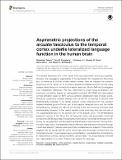| dc.contributor.author | Takaya, Shigetoshi | |
| dc.contributor.author | Kuperberg, Gina R. | |
| dc.contributor.author | Liu, Hesheng | |
| dc.contributor.author | Greve, Douglas N. | |
| dc.contributor.author | Makris, Nikos | |
| dc.contributor.author | Stufflebeam, Steven M. | |
| dc.date.accessioned | 2015-11-03T17:34:37Z | |
| dc.date.available | 2015-11-03T17:34:37Z | |
| dc.date.issued | 2015-09 | |
| dc.date.submitted | 2015-04 | |
| dc.identifier.issn | 1662-5129 | |
| dc.identifier.uri | http://hdl.handle.net/1721.1/99682 | |
| dc.description.abstract | The arcuate fasciculus (AF) in the human brain has asymmetric structural properties. However, the topographic organization of the asymmetric AF projections to the cortex and its relevance to cortical function remain unclear. Here we mapped the posterior projections of the human AF in the inferior parietal and lateral temporal cortices using surface-based structural connectivity analysis based on diffusion MRI and investigated their hemispheric differences. We then performed the cross-modal comparison with functional connectivity based on resting-state functional MRI (fMRI) and task-related cortical activation based on fMRI using a semantic classification task of single words. Structural connectivity analysis showed that the left AF connecting to Broca's area predominantly projected in the lateral temporal cortex extending from the posterior superior temporal gyrus to the mid part of the superior temporal sulcus and the middle temporal gyrus, whereas the right AF connecting to the right homolog of Broca's area predominantly projected to the inferior parietal cortex extending from the mid part of the supramarginal gyrus to the anterior part of the angular gyrus. The left-lateralized projection regions of the AF in the left temporal cortex had asymmetric functional connectivity with Broca's area, indicating structure-function concordance through the AF. During the language task, left-lateralized cortical activation was observed. Among them, the brain responses in the temporal cortex and Broca's area that were connected through the left-lateralized AF pathway were specifically correlated across subjects. These results suggest that the human left AF, which structurally and functionally connects the mid temporal cortex and Broca's area in asymmetrical fashion, coordinates the cortical activity in these remote cortices during a semantic decision task. The unique feature of the left AF is discussed in the context of the human capacity for language. | en_US |
| dc.description.sponsorship | National Institutes of Health (U.S.) (Grant R01NS069696) | en_US |
| dc.description.sponsorship | National Institutes of Health (U.S.) (Grant P41EB015896) | en_US |
| dc.description.sponsorship | National Institutes of Health (U.S.) (Grant S10ODRR031599) | en_US |
| dc.description.sponsorship | National Institutes of Health (U.S.) (Grant S10RR021110) | en_US |
| dc.description.sponsorship | National Science Foundation (U.S.) (Grant NFS-DMS-1042134) | en_US |
| dc.description.sponsorship | Uehara Memorial Foundation (Fellowship) | en_US |
| dc.description.sponsorship | Society of Nuclear Medicine and Molecular Imaging (Wagner-Torizuka Fellowship) | en_US |
| dc.description.sponsorship | United States. Dept. of Energy (Grant DE-SC0008430) | en_US |
| dc.language.iso | en_US | |
| dc.publisher | Frontiers Research Foundation | en_US |
| dc.relation.isversionof | http://dx.doi.org/10.3389/fnana.2015.00119 | en_US |
| dc.rights | Creative Commons Attribution | en_US |
| dc.rights.uri | http://creativecommons.org/licenses/by/4.0/ | en_US |
| dc.source | Frontiers Research Foundation | en_US |
| dc.title | Asymmetric projections of the arcuate fasciculus to the temporal cortex underlie lateralized language function in the human brain | en_US |
| dc.type | Article | en_US |
| dc.identifier.citation | Takaya, Shigetoshi, Gina R. Kuperberg, Hesheng Liu, Douglas N. Greve, Nikos Makris, and Steven M. Stufflebeam. “Asymmetric Projections of the Arcuate Fasciculus to the Temporal Cortex Underlie Lateralized Language Function in the Human Brain.” Frontiers in Neuroanatomy 9 (September 15, 2015). | en_US |
| dc.contributor.department | Harvard University--MIT Division of Health Sciences and Technology | en_US |
| dc.contributor.mitauthor | Stufflebeam, Steven M. | en_US |
| dc.relation.journal | Frontiers in Neuroanatomy | en_US |
| dc.eprint.version | Final published version | en_US |
| dc.type.uri | http://purl.org/eprint/type/JournalArticle | en_US |
| eprint.status | http://purl.org/eprint/status/PeerReviewed | en_US |
| dspace.orderedauthors | Takaya, Shigetoshi; Kuperberg, Gina R.; Liu, Hesheng; Greve, Douglas N.; Makris, Nikos; Stufflebeam, Steven M. | en_US |
| mit.license | PUBLISHER_CC | en_US |
| mit.metadata.status | Complete | |
